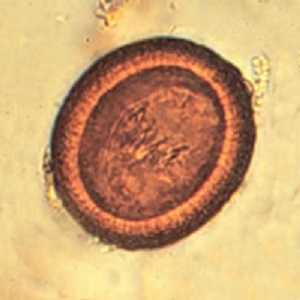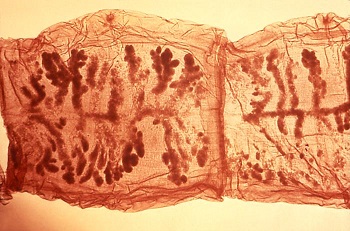Taenia solium - Laboratory Diagnosis
Laboratory diagnosis of Taenia solium
Sample
stool
blood
CSF
biopsy (brain, muscle, meninges)
vitreous humor, aqueous humor
Microscopy
Most commonly, Taenia solium eggs can be observed while scolex and proglottids are less frequent.
Detection of eggs
It is essential to collect 2 to 3 stool samples for the detection of the parasite because eggs and segments are not regularly shed in the stool.
The eggs, if present in the perianal area, can be demonstrated by the cellophane-swab technique. This technique is mostly used for diagnosis of Enterobius vermicularis infection and has a sensitivity of 85% to 90%.
Acid-fast staining of the eggs can be used to differentiate T. saginata from Taenia solium as T. saginata eggs are acid-fast in nature while Taenia solium eggs are non-acid-fast.

Image: T. solium egg (Source: cych.org)
Cellophane-swab technique
It is also called the transparent adhesive tape test or Scotch tape test and is a quick, cost-effective, and painless test. Multiple samples may be collected at home early in the morning before and submitted later to the laboratory/doctor's office.
In this method, a sample from the skin around the anus is collected and examined. The sample must be retrieved before the patient has gotten out of bed, used the bathroom, or taken a bath.
the sticky side of a piece of clear tape (such as Scotch tape) is applied briefly to the skin around the patient’s anus
any eggs or in some cases proglottids present on the skin will stick to the tape
the sticky side of the piece of the tape is pressed to a microscope slide and viewed under a microscope

Image: T. solium proglottids stained with India Ink(Source: Wikimedia commons)
Detection of proglottids
Demonstration of gravid proglottids, obtained from feces or a person’s under clothing, is essential for species identification of Taenia. Injecting stains such as India ink through the genital pore of the proglottids helps in the demonstration of lateral uterine branches
The gravid proglottids are washed with clean water and placed between two slides
the two sides are held together by adhesive tape
proglottids are then examined by hand lens
presence of 7 to 12 lateral branches on each side of the uterine stem in the uterus identifies the tapeworm as Taenia solium
* T. saginata has 10 to 20 lateral branches on each side of the uterine stem
Detection of scolex
Demonstration of scolex can confirm Taenia infection. T. saginata scolex is differentiated from Taenia solium scolex as T. saginata lacks a row of hooks or rostellum.
This is rare as the scolex is not always recovered following treatment.

Image: difference in Taenia scolex (Source: veterinaryparasitology)
Antigen Detection in stool
Coproantigen detection test
Taenia solium infection can also be detected by a coproantigen detection test. They use an antigen-capture ELISA using polyclonal antisera targeting Taenia. The specificity and sensitivity depend on the platform and quality of reagents but can be used for the identification of genus but does not differentiate between species.
Serodiagnosis
This is based on the detection of anti-cysticercus antibodies in the serum or CSF samples. Enzyme-Linked Immunosorbent Assay (ELISA) and Enzyme-linked immunoelectrotransfer blot (EITB) are the most commonly used tests for the diagnosis of NCC as well epidemiological studies.
ELISA
ELISA has low sensitivity (75%) and moderate specificity (85%)
useful in the diagnosis of NCC with few CNS lesions and mild manifestations
EITB
uses a purified fraction of glycoprotein
highly specific (100%) for the detection of antibodies in serum and CSF
in cases of NCC with two or more brain cysticerci involved, sensitivity is at 90% but decreases to 50% to 70% if less than a single brain cysticerci
in children, serum immunoblot assay is used for CSF samples as most have a single lesion
Disadvantages
serodiagnosis detects only exposure but does not differentiate whether the patient has established and viable recent infection
since antibody titers continue to persist in the serum even after Taenia solium has been eliminated, false positives can occur
Molecular diagnosis
Molecular methods are used to detect and differentiate between Taenia species eggs and proglottids.
DNA probe
high sensitivity and specificity
the disadvantage is that if only segments are present and eggs are absent in the sample, it shows a false negative
PCR
detects Taenia eggs in the stool samples
very high sensitivity- even a single egg in the sample can detect and differentiate between Taenia species
Histopathological diagnosis
Cysticercosis, mostly neurocysticercosis (NCC), is diagnosed by the demonstration of cysts in the biopsy/autopsy tissues.
Imaging methods
The imaging procedures can demonstrate dead, calcified, oval, or elongated cysts of Taenia solium. X-ray, CT scan, and MRI can be done to visualize these cysts.